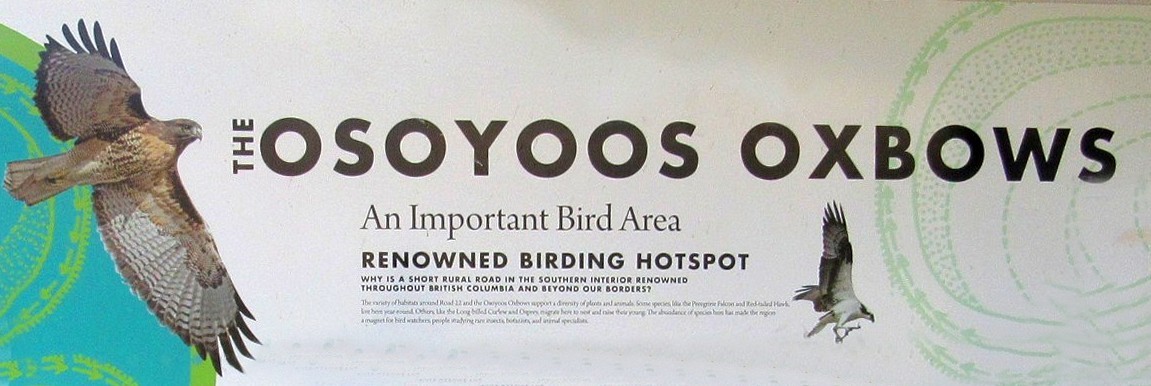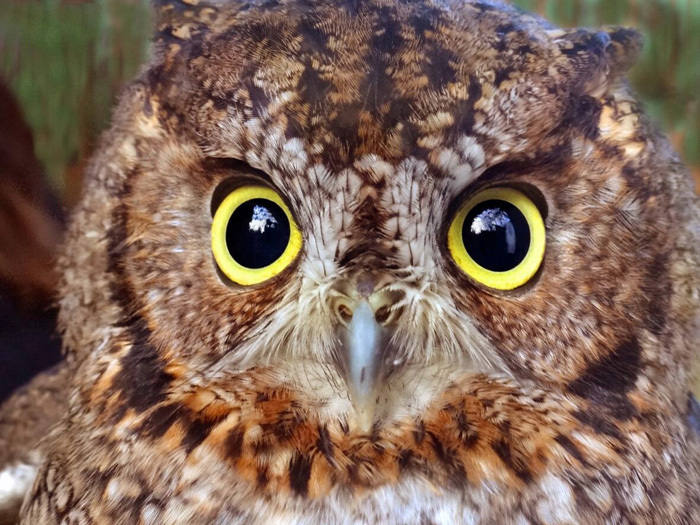
OSOYOOS OXBOWS IMPORTANT BIRD AREA (IBA)
Osoyoos Oxbows is one of 600 sites in Canada and 11,000 sites worldwide that have been designated as Important Bird Areas (IBAs). The IBA program identifies and monitors some of the most vital places in Canada for birds so that conservation action can be directed in the most effective way possible.
The Osoyoos Oxbows area was designated an IBA because it supports nationally significant populations of endangered Yellow-breasted Chats and several other species at risk including Bobolink, Long-billed Curlew and Lewis's Woodpecker. Two rare sparrows, the Lark Sparrow and Grasshopper Sparrow, also live in open grassy and shrubby areas here. Volunteer IBA caretakers work in their communities to promote IBAs, monitor birds and habitats, and ensure that local conservation ideas are put into action.
 SPECIES AT RISK PROFILE: WESTERN SCREECH-OWL
SPECIES AT RISK PROFILE: WESTERN SCREECH-OWL
The B.C. interior population of this medium-sized owl is listed as threatened in Canada due to the small population size (fewer than 500 adults) and loss of riparian woodland habitat suitable for nesting. Screech-Owls nest in large tree cavities made by woodpeckers, although they will also readily nest in owl boxes in suitable habitat. Protecting nesting habitat for this owl is key to its long term survival. Old dead snags and mature trees with woodpecker holes are valuable wildlife trees for owls and other wildlife.
 SPECIES AT RISK PROFILE: YELLOW-BREASTED CHAT
SPECIES AT RISK PROFILE: YELLOW-BREASTED CHAT
With a bright yellow breast and a loud song chats don't seem shy but they prefer dense thickets of rose and deciduous woodlands away from roads and human activity. The British Columbia population has been designated as endangered due to the loss of habitat available in low-elevation valley bottoms where they prefer to live. Research at the Osoyoos Oxbows suggests that Yellow-breasted Chats like to nest near other chats, therefore restoring habitat next to places where they already nest is ideal.
"Osoyoos Oxbows
South Okanagan Valley, British Columbia
Site Description
The Osoyoos Oxbows are located in the South Okanagan Valley in south central British Columbia. The oxbows wind along both sides of the Okanagan River channel from the north end of Osoyoos Lake to north of Road 18, Oliver with further scattered oxbow sections to the north of Oliver. Most of the site lies along the Okanagan River channel, a canal-like structure with gravel dykes. The old river channel winds back and forth across the flat floodplain, which is about 1 km wide. Water birch woodlands line the oxbows, while a cattail-bulrush marsh lies east of the river mouth where it empties into Osoyoos Lake. This marsh once extended to the west side as well, but has largely been drained or filled on that side. Arid, sandy bench-lands lie directly to the east of the floodplain, extending at one spot to an outlying rock bluff with associated talus.
Birds
Significant Species
Osoyoos Oxbows supports nationally significant populations of Western Yellow-breasted Chat (auricollis subspecies); determined to be Endangered by the Committee on the Status of Endangered Wildlife in Canada (COSEWIC; wildlife species that have been assessed as at risk by COSEWIC may qualify for legal protection and recovery under Canada's Species at Risk Act). Intensive surveys conducted in the IBA between 2006 and 2011 detected between 30 - 61 individuals annually, which represents a considerable portion of the estimated British Columbia population of the auricollis subspecies. Endangered (COSEWIC) Western Screech Owls (macfarlanei subspecies; interior population) also roost and feed in the IBA during the winter somewhat regularly. Casual surveys have detected one or two owls in three winters since 2006.
Other Species of Interest
Numerous other national species at risk are present at this site. At least one Barn Own (Threatened in BC; COSEWIC) has been detected in the IBA each year since 2000; in 2012, four were observed. A pair of Lewis's Woodpeckers (Threatened; COSEWIC) has been seen every other year or so since 2001. One or two nationally listed Special Concern (COSEWIC) Peregrine Falcon (anatum subspecies) have been detected in the IBA annually since 2000, and have been confirmed nesting since 2008. One or two pairs of Long-billed Curlews (Special Concern; COSEWIC) have bred in the IBA each year since 2000. In addition, COSEWIC listed Threatened Common Nighthawk, Barn Swallow, and Bobolink occur in the IBA. Other regionally important species that occur here include provincially rare Brewer's Sparrow, Lark Sparrow, and Grasshopper Sparrow.
Osoyoos Oxbows IBA is a hotspot for owls, with as many as eight species occurring in the area, four of which breed regularly: Northern Saw-whet, Long-eared, Great Horned and Barn Owl (Threatened in BC; COSEWIC). Burrowing Owls (Endangered; COSEWIC) were present at this site until the early 1990s and Short-eared Owls (Special Concern; COSEWIC) have been detected.
The marshes at the north end of Osoyoos Lake, remnants of a once significant chain of wetlands in the Okanagan valley bottom, support Northern Harrier, Virginia Rail, and Yellow-headed Blackbird. The easy access along Highway 97 and the high diversity of birds and habitats makes the Osoyoos Oxbows a premier birding site in Canada."
Source: IBA Canada